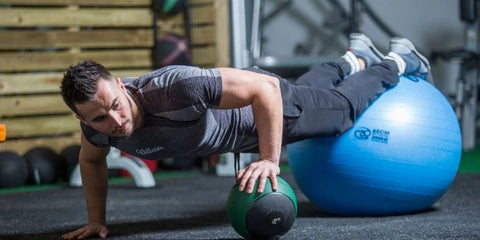
If you have always exercised then continuing to do so after the age of 40 should be no big deal. Your body will be accustomed to the strain and stresses of exercise and therefore should be able to cope with familiar workouts with relative ease.
However even seasoned exercises that have trained since their youth need to be aware that biological changes are taking place. Up to 70% of total energy expenditure comes down to your basal metabolic rate. After 40 this begins to decline linearly with age, around 1-2% per year. The cells of the body also age resulting in muscles and tendons having less resilience.

If you are coming up to 40 and starting an exercise regime for the first time in years then you need to be aware that getting fit at this age is not going to be as easy as it was when you were a youngster. The most common reason why it’s harder to get fit as we age is muscle loss and the older we get the more muscle we loose. Experts still don’t fully understand why this occurs but believe it’s due to a number of factors such as the body’s inefficiency to turn protein into fuel, hormonal changes, inflammation and fewer nerve cells sending signals from the brain to the muscles.
Muscle tissue is also metabolically more active than fat tissue so if we loose muscle it is also harder to burn calories and therefore loose weight.
So why is it that those who have not exercised for years start to consider exercise around the age of 40. In both men and women the body starts to decline after 30 and declines more aggressively every year. In men testosterone levels also start to fall. By the time you reach 40 you are starting to feel the effect of this decline. On top of that family life, raising children and work commitments, could result in you suffering from low energy levels, poor sleep patterns and poor food choices.
You may also start to suffer from niggling aches and pains, stiff muscle and joints as you get out of bed in the morning and poor concentration. Suddenly you realise you are getting older and you are no longer invincible.
Unfortunately we can’t stop the ageing process and no amount of exercise will stop us from getting older but exercise can improve your quality of life and make life after 40 much more enjoyable.
So what are the benefits of exercise after 40?
1) It increases the chemical norepinephrine which helps reduce stress
2) Reduces the risk of heart disease and certain cancers such as breast and colon cancer.
3) Improves bone mineral density (particularly in women) and decreases the risk of osteoporosis
4) Lowers blood pressure
5) Releases endorphins, the hormone that creates the feeling of happiness, euphoria and wellbeing
6) Boosts a chemical in the brain that can prevent degeneration and reduce the risk of diseases such as Alzheimer’s
7) Builds muscle, which improves strength, which in turn improves mobility and flexibility. This reduces the risk of developing and/or alleviating arthritis symptoms as well as reducing the risk of falls, which is common in older people.
8) Improves coordination
9) Can reduce type 2 Diabetes and in some cases eliminate it completely.
10) Boosts the immune system
11) Reduce back pain
12) Burns calories and helps with weight loss
13) Improves skin texture and reduces wrinkles
14) Improves sleep
The benefits of exercise are many and the good news is it’s never too late to start.
There are five main elements to overall fitness in older adults:
1. Cardiovascular exercise
2. Strength training
3. Flexibility
4. Balance training
5. Good diet

The key to a successful fitness regime starting in your 40’s is to start slowly and build up. Begin with what you find manageable and be under no illusion that the first couple of weeks will feel uncomfortable. Look at the long-term goal and treat the process as a marathon and not a sprint. This gradual approach will help you develop a mental attitude to exercise, which is just as important as the physical aspect, at the same time as avoiding injury.
Do not ignore any of the five elements of fitness. Men have a tendency to concentrate on strength training, because they want the ‘ripped’ muscular appearance and ignore the cardiovascular. Women on the other hand do the opposite and concentrate on CV as they think it’s the best way to loose weight, which is often their ultimate goal. They ignore weights because they are frightened they will look like a body builder but this will not be the case, as they don’t have the testosterone levels of a man. Women are more likely to finish up with a slim, toned body.
Both CV and strength training are as important as each other to achieve both sets of goals for both sexes.
Stretching will improve flexibility but they need to be the correct stretching exercises, so do a bit of research so you get the optimum result from a stretching programme.
Balance exercises can significantly reduce the risk of falls.
Finally diet is important. The adage ‘you are what you eat’ is very true and this is more so when including it with an exercise routine. Eating the right foods will help you get the calories and nutrients that will fuel your exercise and achieve your goals. Remember, there’s no one-size fits all when it come to nutrition. You have to design your diet around your exercise regime and your ultimate goal.
To keep up an exercise programme its important you chose an exercise you enjoy. What you enjoyed doing as a kid you may still enjoy now. If cycling was your thing, then try using an exercise bike, if you were a runner then a treadmill (or a cross trainer) seems the obvious choice.
Because a body at 40 plus is different to a 20 year old body consider exercises that are low impact but still offer a decent calorie burn such as brisk walking or cycling. Strength training will jump start your metabolism but start with low weights, slow reps and build up.
The next question, how much exercise should someone 40 plus do? Ideally 30 minutes 5 days a week of moderate cardiovascular exercise or 15 minutes of vigorous cardiovascular activity 5 days a week. Of course in the beginning you may find this far too much and you could start with as little as 5-7 minutes a day three times a week. Remember, slow and steady at the start. You will also need to do strength training at least three times a week with the routine covering all major muscle groups.
To someone coming to exercise for the first time after a long lay off this will seem daunting. One way this can be achieved without taking up every spare minute is to cross train, combining strength and CV in the same workout session. At the gym this will be easy to achieve but if you train at home you will need both CV and strength equipment, such as an exercise bike and a multi gym or bench and free weights. You do 2 minutes CV followed by strength training a specific body part then back to 2 minutes CV again and so on and so on. However there are many programmes out there that you can find on line or in books that focus on training programmes for the over 40’s and above and will fit into your individual lifestyle.
Finally it’s worth mentioning that as you get older there will be some exercises that should be avoided or performed with caution.
1) Long runs outside or on a treadmill will put a strain on knee joints. However the treadmill is less likely to cause a problem due to their cushioned running deck. To remove all shock, yet still get a running action, use a cross trainer.
2) Abdominal Crunches, Power Clean and Deadlifts as these three strength exercise put a huge strain on the lower back. Back pain being one of the main reasons for days off work in the UK.
3) High Intensity Interval Training. HIIT has taken the fitness industry by storm but for older adults returning to exercise, if it is done too vigorously it could be dangerous.
4) Behind the neck Lat Pulldown. This can increase your risk of rotator cuff injuries. Better to do front Lat Pulldowns.
5) Squats/ Leg Press are great leg exercises but put a huge strain on older backs and knees.
6) Stair Climbing can be very strenuous and has the potential to over strain the heart.
Conclusion
Regular physical activity as we age improves both physical and mental functions. It can reverse some of the effects of chronic disease and help keep older people mobile and independent. It is really important to remember that it never too late to start. Evidence has shows that the correct regular exercise is safe and effective even for frail people in there 80’s and 90’s. It will help keep at bay cardiovascular disease, stroke, falls, osteoporosis, obesity, cognitive impairment and muscular weakness. However there is dilemma. As we get older we become more interested in keeping our health and fitness benefits that we had when we were younger but at the same time as we age we become less interested in improving our health. So not only do older people have to get through the physical aspects of a new exercise regime they also have to change their mental outlook as well.
To get over this starting out an exercise programme with friend or going to a class of your peers may be one way. Finally don’t try to achieve everything at once. Take your time because you want to make excise part of your life and if you do the the benefits are enormous.

